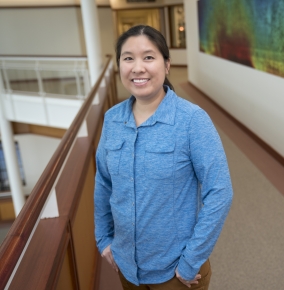Amy Watson

What are you working on at the Laboratory?
I am the software lead for a fielded ground system that supports open-air flight testing and a hardware-in-the-loop system that supports laboratory testing. Not only have I been able to help build and deploy these test systems, but I have the opportunity to operate them during tests, analyze the data, and present the results to both important and large audiences.
How has your career evolved at the Laboratory?
I came to the Laboratory as a college graduate with a computer science degree and no technical background in radar, which is one of the main focuses of the Laboratory. While initially working on software projects that supported integrating hardware into complex systems that contributed to operational data feeds for various government agencies like the FAA [Federal Aviation Administration], I became very interested in seeing the operation of these systems and identifying areas to improve or enhance their functionality. My group helped to identify projects in which I could participate in a more hands-on capacity; from deploying software in the field, to being a test observer and operator, to eventually collaborating with test planning and execution, and then post-mission data analysis. These tasks require skills that go above and beyond what I had studied in school. I also took an assignment at the Nevada field site, working on systems that have been deployed to very remote locations, and had the opportunity to participate in incredibly unique experiences that go beyond the standard “desk job.”
What has been the most interesting project you have been involved in?
Most flight tests are planned well in advance, but one test had to be planned in the span of a month and required building, testing, and deploying a new ground station from scratch. This test required a large collaborative effort by many skilled people across the Laboratory with whom I was fortunate to work. Being able to support such a fast-turnaround project, and seeing it come to fruition from an initial telephone call to watching it being tested with an aircraft on the flight line of an Air Force base, to deploying it in a remote location less than 30 days from that phone call, was an impressive feat, and I was happy to have been a key player on that team.
What makes the Lab a unique place to work?
The Lab is a mix between academia and industry; we are able to apply emerging technology to current and immediate real-world problems, and we can transition that technology to industry partners to address other new or emerging issues. I also find that the people I have worked with at the Laboratory are smart and motivated to work with each other, and that can often be a rare combination as well.
Are you involved in any of the Lab’s employee resource groups (ERGs) or outreach programs? If so, what has been your experience with those activities?
I am a member of PALS (Pan-Asian Laboratory Staff), which fosters professional development and promotes awareness of issues pertaining to the AAPI [Asian Americans and Pacific Islanders] community. Being in an ERG is a nice opportunity to meet other people in the Lab and share your experiences with each other, and see how those experiences are similar and different.